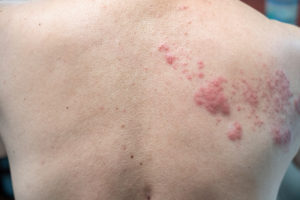Early Treatment Can Significantly Ease The Pain & Duration Of Shingles
Posted on May 02, 2019
 Shingles has a dreaded reputation because it can be SO painful and can last SO long.
Shingles has a dreaded reputation because it can be SO painful and can last SO long.
For some, the pain can be so intense that it sends patients to the emergency room. There, it may be mistaken for problems of the heart, lungs or kidneys.
The signs and symptoms of Shingles include:
- Pain, burning, or tingling
- An itchy, red raised rash
- Fluid-filled blisters
- Fever
- Fatigue
Two to four days before the rash appears, some people have tingling or SEVERE, sharp pain in the area. For most Shingles, the rash and painful symptoms can last for two to four weeks.
Shingles is a viral infection that commonly causes a painful rash. It can occur anywhere on the body. Most patients who develop Shingles have a rash of blisters that wraps one side of the torso. However, some rashes can form around one eye or on one side of the face or neck. Some people experience Shingles pain without developing a rash.
Shingles is caused by the same virus that causes chickenpox. After you’ve had chickenpox, the virus remains dormant in nerve tissues near the spine and brain. Years later, the virus may reactivate as Shingles.
Although many who develop Shingles feel they “have to suffer through it,” early response can make a significant difference in comfort and duration. Through a procedure called selective nerve root (SNR) injection, our Pain Medicine physicians administer a long-acting steroid to the affected nerve root(s). Through this procedure, the pain and duration of Shingles can be significantly reduced, if not eliminated.
At Advanced Pain Management & Spine Specialists, Shingles is deemed as a Pain Emergency that should be treated as quickly as possible. Patients with Shingles should be evaluated and treated within 24 hours. These patients are given priority status on appointments, hopefully being seen the same day.
Why the urgency?
In addition to reducing pain and the duration of Shingles, early treatment can help you to avoid problems that can be much worse. For people who are ages 60 or older or have weakened immune systems (due to chronic illness, medications, etc.), the risk for complications greatly increases.
These include:
- Postherpetic Neuralgia – After the blisters of Shingles have cleared, the pain remains for some patients. This occurs when the virus permanently damages the nerve fibers and sends altered messages to the brain.
- Neurological Problems – In some instances, Shingles can lead to inflammation of the brain (encephalitis), facial paralysis, hearing loss or vertigo.
- Vision Loss – When the pain and rash occurs near an eye, the infection can lead to permanent eye damage.
Dr. Jonathan Daitch and Dr. Ivan Samcam are pain physicians at the Fort Myers pain management office of Advanced Pain Management & Spine Specialists (APMSS). Both are specially trained to help minimize the misery of Shingles. If you or someone you know has developed Shingles, call 239-437-8000 without delay.